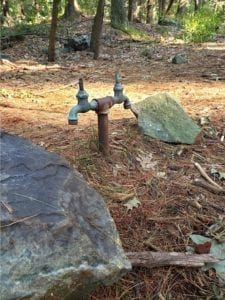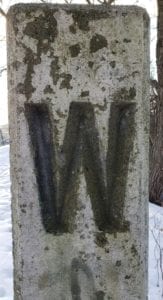 I re-discovered one of my all time favorite Village 14 features in the last few days.
I re-discovered one of my all time favorite Village 14 features in the last few days.
In the summer of 2020, Village 14 contributor Bruce Henderson unveiled a slow moving contest. Each week, over nine weeks of the summer, Bruce posted five photos from his very impressive collection of strange, odd, eccentric, or inexplicable things that you could see from a public way somewhere in Newton in his Newton Photo Scavenger Hunt. If you missed it the first time around its worth a look.
V14 reader’s were invited to identify where each of the object could be found and share any details they knew about them. Over nine weeks, points were scored, scores were tallied and after a Herculean effort, V14 regular Michael came out victorious.
Bruce’s photos have just inspired me to create imaginary history’s (below) for a few of these objects.
There’s no reason you can’t get in on this fun. Is there anything you ever wondered about some detail of Newton’s past? Rather than Google it, rather than doing careful historical research, we invite you to just make it up and create your own imaginary history in the comment section below.
Here are my contributions inspired by Bruce’s Scavenger hunt …

42. Faucet in Woods
Photo Scavenger Hunt #42 … it could have happened ….
Today’s Kennard Park is woods, but all the woods there are new growth. In the late 1800’s all of this Newton land and across the border into Brookline was all farmland. The Kennard family’s farm ran right to the Brookline border where it met the Grigg’s family farm at the Brookline town land.
Despite the fact that the Kennard family and the Grigg family had lived as neighbors for generations, they were never particularly friendly, and they had multiple acrimonious disputes spanning back many years.
In the late 1870’s both Newton and Brookline began working on their first public water systems. Both towns began building their first systems by pumping water from the Charles River into reservoirs and then distributing from there to the rest of the town. Eventually in the early 1900’s both towns replaced much of those systems when they later became part of the regional Metropolitan Water District.
In the 1870’s, in both towns, the construction of a municipal water system was very exciting news to all the residents. In Newton, the first reservoir (the Waban Hill Reservoir) was constructed alongside Commonwealth Ave (near today’s Boston College campus). At that time, that end of Newton was already very residential and new homes were steadily being added. The Newton water system began being built outward from there. The Kennard farm at the Brookline border was miles away, out in a largely uninhabited portion of Newton dotted sporadically with small farms. It would likely be many years before the new Newton water pipes would reach the Kennard’s land.
Meanwhile, Brookline was building the Chestnut Hill Reservoir alongside what is now Rt 9, and the town’s first round of distribution pipes included a main line right to the Newton town border terminating at the Griggs property.
Once the Brookline town water began flowing to the Griggs Farm, Nat Griggs took great delight in taunting his Newton neighbor Richard Kennard on a nearly daily basis about how he wasn’t likely to see a drop of Newton water any time in this century. The constant jeering and taunting only added to the bad blood between the families.
Despite the personal enmity between them, less than a year later Kennard approached Griggs with a financial proposition. If Griggs would allow Kennard to lay his own water pipe from the Brookline main at the edge of the Griggs property a quarter mile into Kennard’s Newton farm, Kennard would pay him an annual rent for the illicit pipe.
It was an intensely acrimonious negotiation but after months of squabbling they agreed that:
• Kennard would pay an annual rent of $12 to Griggs
• Griggs would be able to use Kennard’s pipe to supply the Griggs land nearest Kennard.
That final sticking point was resolved thusly. Wrote Kennard “I will install two taps upon that accursed pipe. The west facing tap will be for my sole use, and the east facing tap for yours. Nary a drop must ever spill from the Kennard tap for your use, or forever ever after my water rent shall be free<>”
They laid the pipe and turned on the water.
Two years later the town of Brookline discovered that Griggs was selling Brookline water to his Newton neighbors and both were brought up on charges. The illegal Kennard water line was disconnected. Both parties were fined heavily and the two headed tap in the Kennard woods that remains today was a daily reminder to Richard Kennard, until his dying day, of the bitter blood between them.
Note: Anything that is actually true in the above account is purely by accident.

35. W Post
Photo Scavenger Hunt #35 … it could have happened ….
“The early 1900’s was a time of very different social norms than today. Towards the turn of the century it was not deemed appropriate for single woman to travel un-escorted with male companions. This social standard had the side effect of severely limiting women’s freedom of movement, in a time when the world was opening up with new transportation technologies.
Jason Werb, an enterprising young Upper Falls entrepreneur, sensed an opportunity and seized it. For a few short years from 1909-1911 Werb’s “Saturday Social Trains” ran from Upper Falls to Boston. Werb sub-contracted trackage rights with the owners of the Needham Circuit Line, which ran from Upper Falls, through Needham, and then around through Dedham into Boston – which he dubbed the “Women’s Line”, while also sub- contracting with the Boston and Albany Railroad for the route from Upper Falls to the Highlands and into Boston (now the Riverside line) he dubbed the “Gentleman’s Line”.
Werb’s insight was that if the young single folks were segregated by gender on the different train lines, their parents would be comfortable letting their daughters out in the larger world without escorts. For two short years, every Saturday morning, trains full of happy young men boarded the “Gentleman’s Line” train at the Upper Falls station headed in one direction, and happy young women boarded the Women’s Line in the opposite direction. As the bell rang and both trains left the same station, on the same track, but in different direction, the Upper Falls parents rested easy, knowing that their children were behaving properly and safely. What most of those parents didn’t realize was that the two trains arrived within 10 minutes of each other at the same Boston station. Young couples reunited in the Boston station and spent a glorious day of un-escorted escapades together in down town Boston before catching the return trains home at 5 PM..
One physical trace of this fascinating technological, business, and social history can still be seen today on the Upper Falls Greenway – the former route of both the Gentleman’s and Women’s Lines. Just short of where the Greenway meets the Charles River there is a marble column etched with the letter “W”. The matching column with the letter “G” in the Highlands has long since disappeared.
Note: Anything that is actually true in the above account is purely by accident.

If I get a bit of time I may have to also write a profile of Newton’s renowned West brothers from the 1700’s. Charles West was the remarkable man that West Newton was named after … and his equally interesting brother Ezekiel West who left home at a young age and moved to Boston, where West Roxbury was named after him.